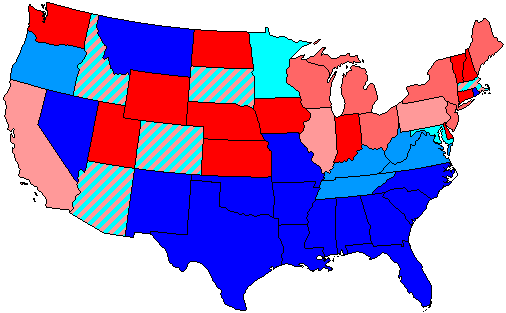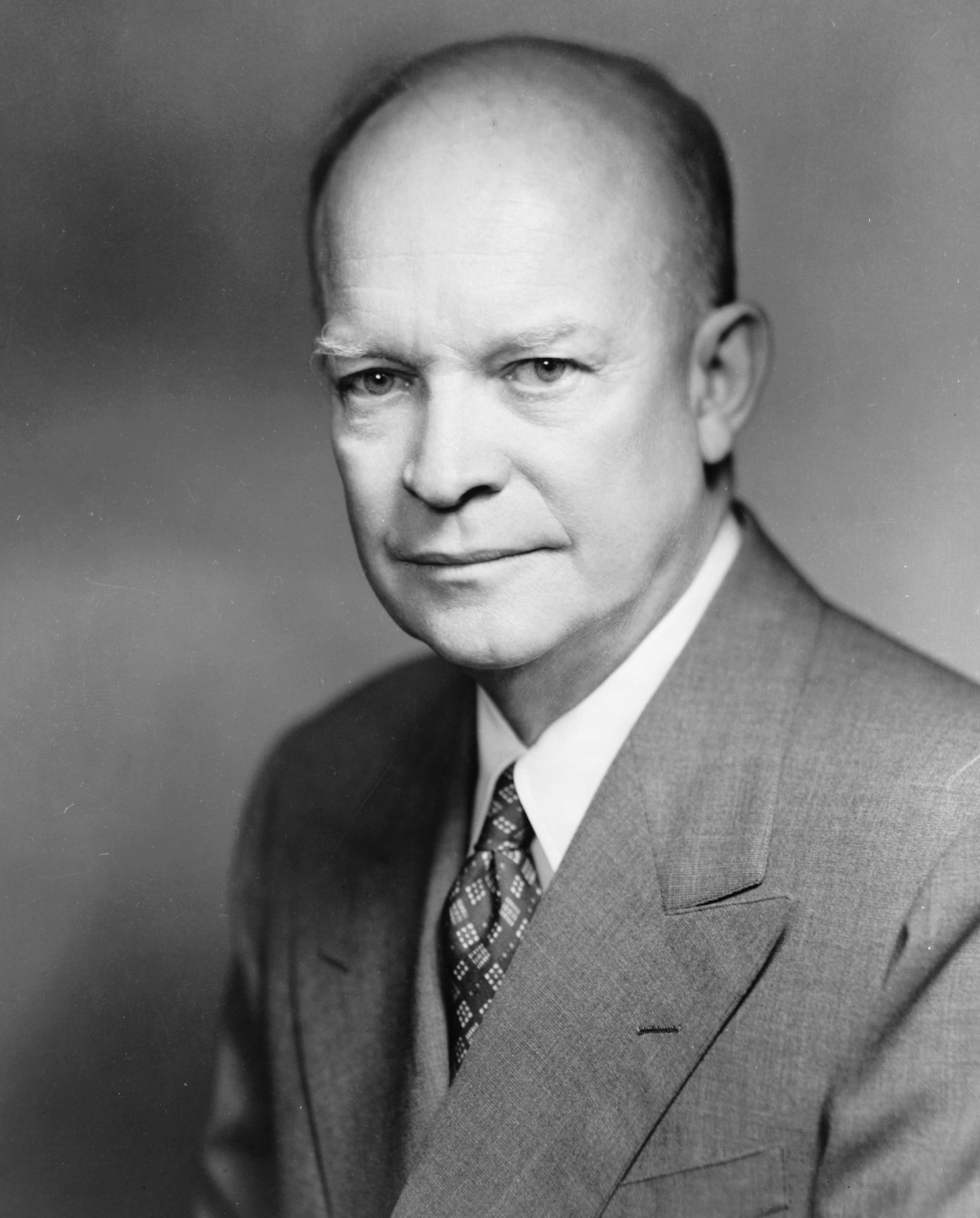|
84th Congress
The 84th United States Congress was a meeting of the legislative branch of the United States federal government, composed of the United States Senate and the United States House of Representatives. It met in Washington, D.C. from January 3, 1955, to January 3, 1957, during the third and fourth years of Dwight D. Eisenhower's presidency. The apportionment of seats in the House of Representatives was based on the Seventeenth Census of the United States in 1950. The Democratic Party won back majorities in both the House and Senate, thus giving them full control of Congress, although Republican Party won the Senate in the last Congress. Major events * January 28, 1955: Congress authorized the President to use force to protect Taiwan from the People's Republic of China * February 10, 1955: The United States Navy helped the Republic of China evacuate Chinese Nationalist army and residents from the Tachen Islands to Taiwan. * February 12, 1955: President Eisenhower sent the first ... [...More Info...] [...Related Items...] OR: [Wikipedia] [Google] [Baidu] |
United States Capitol
The United States Capitol, often called The Capitol or the Capitol Building, is the seat of the legislative branch of the United States federal government, which is formally known as the United States Congress. It is located on Capitol Hill at the eastern end of the National Mall in Washington, D.C. Though no longer at the geographic center of the federal district, the Capitol forms the origin point for the street-numbering system of the district as well as its four quadrants. Central sections of the present building were completed in 1800. These were partly destroyed in the 1814 Burning of Washington, then were fully restored within five years. The building was later enlarged by extending the wings for the chambers for the bicameral legislature, the House of Representatives in the south wing and the Senate in the north wing. The massive dome was completed around 1866 just after the American Civil War. Like the principal buildings of the executive and judicial branches ... [...More Info...] [...Related Items...] OR: [Wikipedia] [Google] [Baidu] |
AFL–CIO
The American Federation of Labor and Congress of Industrial Organizations (AFL–CIO) is the largest federation of unions in the United States. It is made up of 56 national and international unions, together representing more than 12 million active and retired workers. The AFL–CIO engages in substantial political spending and activism, typically in support of progressive and pro-labor policies. The AFL–CIO was formed in 1955 when the American Federation of Labor and the Congress of Industrial Organizations merged after a long estrangement. Union membership in the US peaked in 1979, when the AFL–CIO's affiliated unions had nearly twenty million members. From 1955 until 2005, the AFL–CIO's member unions represented nearly all unionized workers in the United States. Several large unions split away from AFL–CIO and formed the rival Change to Win Federation in 2005, although a number of those unions have since re-affiliated, and many locals of Change to Win are either part ... [...More Info...] [...Related Items...] OR: [Wikipedia] [Google] [Baidu] |
Air Pollution Control Act
The Air Pollution Control Act of 1955 (, ch. 360, ) was the first U.S. federal law to address the national environmental problem of air pollution. This was "an act to provide research and technical assistance relating to air pollution control". The act "left states principally in charge of prevention and control of air pollution at the source". The act declared that air pollution was a danger to public health and welfare, but preserved the "primary responsibilities and rights of the states and local government in controlling air pollution". The act put the federal government in a purely informational role, authorizing the United States Surgeon General to conduct research, investigate, and pass out information "relating to air pollution and the prevention and abatement thereof". Therefore, The Air Pollution Control Act contained no provisions for the federal government to actively combat air pollution by punishing polluters. The next Congressional statement on air pollution would ... [...More Info...] [...Related Items...] OR: [Wikipedia] [Google] [Baidu] |
In God We Trust
"In God We Trust" (also rendered as "In God we trust") is the United States national motto, official motto of the United States and of the U.S. state of Florida. It was adopted by the U.S. Congress in 1956, replacing ("Out of many, one"), which had been the ''de facto'' motto since the initial design of the Great Seal of the United States. While the earliest mentions of the phrase can be found in the mid-19th century, the origins of this phrase as a political motto lie in the American Civil War, where Union (American Civil War), Union supporters wanted to emphasize their attachment to God and to boost morale. The capitalized form "IN GOD WE TRUST" first appeared on the Two-cent piece (United States), two-cent piece in 1864; it was not printed on Federal Reserve Note, paper currency until 1957 and on some postage stamps until 1954. A law passed in July 1955 by a joint resolution of the 84th United States Congress, 84th Congress () and approved by President Dwight Eisenhower requ ... [...More Info...] [...Related Items...] OR: [Wikipedia] [Google] [Baidu] |
Flood Control And Coastal Emergency Act
A flood is an overflow of water ( or rarely other fluids) that submerges land that is usually dry. In the sense of "flowing water", the word may also be applied to the inflow of the tide. Floods are an area of study of the discipline hydrology and are of significant concern in agriculture, civil engineering and public health. Human changes to the environment often increase the intensity and frequency of flooding, for example land use changes such as deforestation and removal of wetlands, changes in waterway course or flood controls such as with levees, and larger environmental issues such as climate change and sea level rise. In particular climate change's increased rainfall and extreme weather events increases the severity of other causes for flooding, resulting in more intense floods and increased flood risk. Flooding may occur as an overflow of water from water bodies, such as a river, lake, or ocean, in which the water overtops or breaks levees, resulting in some of t ... [...More Info...] [...Related Items...] OR: [Wikipedia] [Google] [Baidu] |
Career Incentive Act
The career is an individual's metaphorical "journey" through learning, work and other aspects of life. There are a number of ways to define career and the term is used in a variety of ways. Definitions The ''Oxford English Dictionary'' defines the word "career" as a person's "course or progress through life (or a distinct portion of life)". This definition relates "career" to a range of aspects of an individual's life, learning, and work. "Career" is also frequently understood to relate to the working aspects of an individual's life - as in "career woman", for example. A third way in which the term "career" is used describes an occupation or a profession that usually involves special training or formal education, considered to be a person's lifework. In this case "a career" is seen as a sequence of related jobs, usually pursued within a single industry or sector: one can speak for example of "a career in education", of "a criminal career" or of "a career in the building trade ... [...More Info...] [...Related Items...] OR: [Wikipedia] [Google] [Baidu] |
Formosa Resolution
The Formosa Resolution of 1955 was a joint resolution passed by the U.S. Senate and signed by U.S. President Dwight D. Eisenhower on January 29, 1955, to counteract the threat of an invasion of Taiwan (Republic of China) by the People’s Republic of China (PRC). The resolution gave the U.S. President the authority “to employ the Armed Forces of the United States as he deems necessary for the specific purpose of securing and protecting Formosa and the Pescadores against armed attack y the Communists��. The resolution was formulated amid the Taiwan Strait Crisis (1954–1955), which was a brief period of armed conflict that involved incursions made by the Chinese Communist Party (CCP) on the islands in the Taiwan Strait controlled by the Kuomintang (KMT) led Republic of China (ROC). A latent response by the United Nations Security Council regarding these developments prompted U.S. President Eisenhower to request the resolution in January 1955. Background Early Sino-American rela ... [...More Info...] [...Related Items...] OR: [Wikipedia] [Google] [Baidu] |
United States House Of Representatives Elections, 1956
The 1956 United States House of Representatives elections was an election for the United States House of Representatives in 1956 which coincided with the re-election of President Dwight D. Eisenhower. With no major national issues and the economic upswing of the 1950s in full force, voters generally chose to uphold the status quo, keeping the Republican president and the Democratic Congress. Overall results Special elections In these special elections, the winner was seated during 1956 or before January 3, 1957; ordered by election date. Alabama Arizona Arkansas California Colorado Connecticut Delaware Florida Georgia Idaho Illinois Indiana Iowa Kansas Kentucky Louisiana Maine Maryland Massachusetts Michigan Minnesota Mississippi Missouri Montana Nebraska Nevada New Hampshire New Jersey New Mexico New York North Carolina North Dakota Oh ... [...More Info...] [...Related Items...] OR: [Wikipedia] [Google] [Baidu] |
United States Senate Elections, 1956
The 1956 United States Senate elections were elections for the United States Senate that coincided with the re-election of President Dwight D. Eisenhower. The 32 seats of Class 3 were contested in regular elections, and three special elections were held to fill vacancies. Although Democrats gained two seats in regular elections, the Republicans gained two seats in special elections, leaving the party balance of the chamber unchanged. Democrats defeated incumbents Herman Welker (R-Idaho), George H. Bender (R-Ohio), and James H. Duff (R-Pennsylvania), as well as winning a Republican-held seat in Colorado. Republicans defeated incumbent Earle C. Clements (D-Kentucky) as well as winning Democratic-held seats in Kentucky, New York, and West Virginia. Thus, this election caused Kentucky's Senate delegation to flip from two Democrats to two Republicans. During the next Congress, Republican John D. Hoblitzell Jr. was appointed to the seat of deceased Senator Matthew M. Neely (D-WV), ... [...More Info...] [...Related Items...] OR: [Wikipedia] [Google] [Baidu] |
1952 United States Presidential Election
The 1952 United States presidential election was the 42nd quadrennial presidential election and was held on Tuesday, November 4, 1952. Republican Dwight D. Eisenhower won a landslide victory over Democrat Adlai Stevenson II, which ended 20 years of Democratic rule that stretched back to 1932. Illinois Governor Stevenson, emerged victorious on the third presidential ballot of the 1952 Democratic National Convention by defeating Tennessee Senator Estes Kefauver, Georgia Senator Richard Russell Jr., and other candidates. The Republican nomination was primarily contested by Eisenhower, a general who was widely popular for his leadership in World War II, and the conservative Ohio Senator Robert A. Taft. With the support of Thomas E. Dewey and other party leaders, Eisenhower narrowly prevailed over Taft at the 1952 Republican National Convention with Richard Nixon, a young senator from California, as his running mate. In the first televised presidential campaign, Eisenhower, in sharp ... [...More Info...] [...Related Items...] OR: [Wikipedia] [Google] [Baidu] |
Adlai Stevenson II
Adlai Ewing Stevenson II (; February 5, 1900 – July 14, 1965) was an American politician and diplomat who was twice the Democratic nominee for President of the United States. He was the grandson of Adlai Stevenson I, the 23rd vice president of the United States. Raised in Bloomington, Illinois, Stevenson was a member of the Democratic Party. He served in numerous positions in the federal government during the 1930s and 1940s, including the Agricultural Adjustment Administration, Federal Alcohol Administration, Department of the Navy, and the State Department. In 1945, he served on the committee that created the United Nations, and he was a member of the initial U.S. delegations to the UN. In 1948, he was elected governor of Illinois, defeating incumbent governor Dwight H. Green in an upset. As governor, he reformed the state police, cracked down on illegal gambling, improved the state highways, and attempted to cleanse the state government of corruption. Stevenson also sou ... [...More Info...] [...Related Items...] OR: [Wikipedia] [Google] [Baidu] |
1956 United States Presidential Election
The 1956 United States presidential election was the 43rd quadrennial presidential election. It was held on Tuesday, November 6, 1956. President Dwight D. Eisenhower successfully ran for reelection against Adlai Stevenson II, the former Illinois governor whom he had defeated four years earlier. This election saw the sixth and most recent rematch in presidential history, and the second where the winner was the same both times. Eisenhower, who had first become famous for his military leadership in World War II, remained widely popular. A heart attack in 1955 provoked speculation that he would not seek a second term, but his health recovered and he faced no opposition at the 1956 Republican National Convention. Stevenson remained popular with a core of liberal Democrats, but held no office and had no real base. He defeated New York Governor W. Averell Harriman and several other candidates on the first presidential ballot of the 1956 Democratic National Convention. Stevenson called ... [...More Info...] [...Related Items...] OR: [Wikipedia] [Google] [Baidu] |
.jpg)





.jpg)

.jpg)
